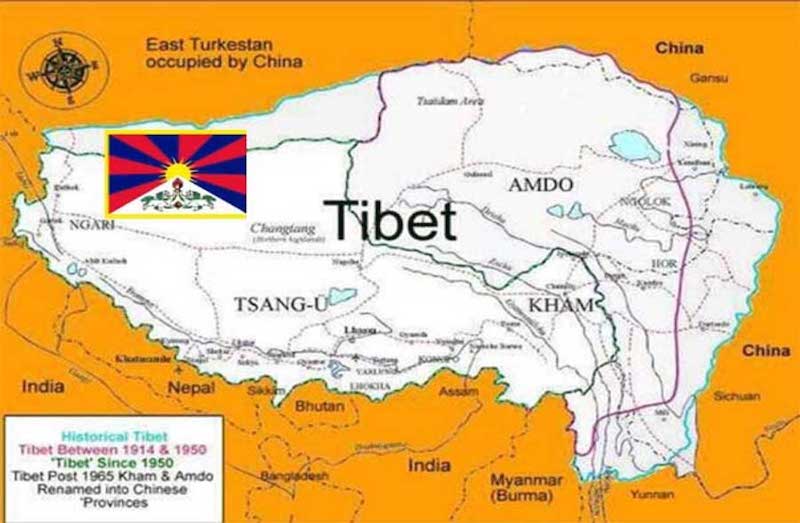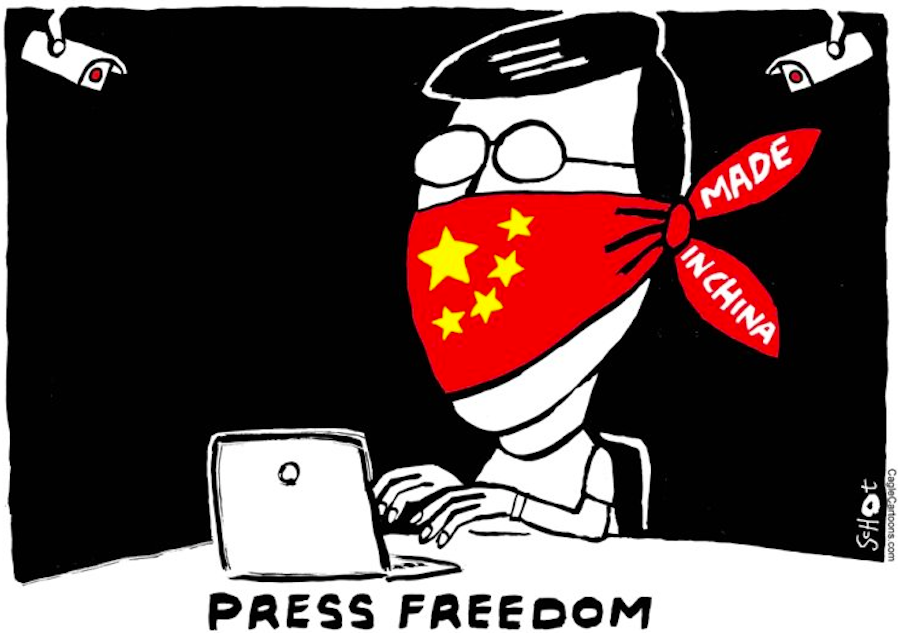By Prof. Ramu Manivannan
There are several reasons to believe, as to why Tibet is important for India. The most significant reason is that Tibet is India’s neighbour. The Government of India no longer openly acknowledges this simple truth due to Tibet’s present status under China. The historical failure to defend Tibet as an independent nation has left us with a failed conscience and swelling loss of national memory. Jawaharlal Nehru’s charisma and overwhelming influence helped him to prevail over other colleagues including Sardar Patel especially on matters of foreign policy. We have lost our historical opportunity in defining Tibet policy right after becoming an independent nation and before independence British India’s policy was mainly to secure British Empire’s geo-strategic interests without any consideration of Tibet’s history and interests. Since the 1950s, we have continued to conduct our China policy within the framework set by China through aggressive means and coercive tactics. We need to trace our steps back and restore the geostrategic, political, physical-geographical, and cultural understanding of Tibet with the historical developments instead of surrendering our conscience to the Chinese dictum.
In the contemporary analysis of history since Indian independence, China demonstrated enormous interest and urgency about Tibet, while India failed to perceive the implications of Chinese military moves inside Tibet since 1949. Chinese invasion of Tibet had begun even before the signing of the Panchsheel Agreement between India and China on 29th April 1954. Chinese knew what they wanted from the Panchesheel Agreement while the Indian government led by Nehru considered peace and friendship with China vital for India’s pursuit of independent foreign policy at the time when bipolar competition was reining the international politics.
There are no flaws with the lofty ideals of Panchsheel, or the Five Principles of Peaceful Co-existence but the challenge lies in the genius of its applications to steer our foreign policy. The essence of Panchsheel includes that we reserve the right to defend our national interests. There is a fundamental difference in the objectives of the Panchsheel agreement as demonstrated by the Indian government and the People’s Republic of China (PRC). Tibet had already emerged as the core interest of China at the time of the signing of the Panchsheel Agreement in April 1954. Nehru viewed Panchsheel as the principled core of the Non-Aligned Movement and as the basis of an alternative world order. China, on the other hand, considered the third principle of mutual non-interference as the condition for the fifth principle of peaceful co-existence and consistently evoked this principle as an instrument to seek India’s silence over Tibet whenever India raised its legitimate concerns over Tibet. Panchsheel agreement took away India’s voice over Tibet and forced an unbelievable silence upon the conduct of India’s foreign policy vis-à-vis Chinese occupation of Tibet.
The Ministry of External Affairs (MEA), Government of India observed during the 50th anniversary of the Panchsheel Agreement in 2004 that “fifty years later, on the golden anniversary of Panchsheel, the chord that was struck in 1954 still rings pure and true in a world yet seeking the lodestar that will guide it into the harbor of peaceful co-existence.” In retrospect over these fifty years since the signing of Panchsheel, the Chinese military has taken complete control over the entire Tibetan nation and its people. China has fully occupied Tibet and made territorial – administrative changes that would force transform the identity and culture of Tibetans forever by removing Amdo and Kham from the traditional Tibetan physical and political geography of Tibet. Tibet has been divided and traditional Tibetan territories in the east such as Amdo and Kham have been tucked into Chinese provinces of Qinghai and Sichuan.
Chinese dangle the western and central Tibet as Tibetan Autonomous Region (TAR) with Lhasa as its Shangri-la before the world after clamping complete control over the land and its people including the everyday conduct of spiritual-religious life inside the Buddhist monasteries. The Potala Palace is itself under siege with layers of military, political and intelligence surveillance. In brief, it is not that Tibet has been lost to China but India has lost Tibet as its neighbor. India’s border issues, at large, with China, rest in the tragedy of Tibet caused by the military and political occupation of Tibet by the People’s Republic of China (PRC). This is one of the most significant shifts in and around India’s political geography after the tribal invasion of Kashmir by Pakistan in 1948. This argument is further strengthened by the Sino-Pakistan Agreement in 1963 due to its enormous legal, political, and geo-strategic implications for India with the Chinese claiming sovereignty over hundreds of square kilometers of land in Northern Kashmir and Ladakh.
China’s 1962 aggression against India was more due to anger and frustrations over the fact that India gave asylum to His Holiness Dalai Lama and eighty thousand Tibetans who came along and after him since the tragic circumstances of 1959. China simply employed a custom made cartographer’s ploy to launch an attack and expand the border dispute to other areas as well. Chinese are masters in manufacturing maps according to their political moods like their skill in duplicating technology from other countries to meet the market needs. Chinese maps and technology lack credibility while their intellectual properties cannot be traced. On the other hand, Chinese propaganda and claims over other’s legitimate territories lie in the making of Han dominant China and as part of the intrinsic strategic culture of the middle kingdom.
China has border issues and territorial disputes with all its immediate neighbours and the far away ones. It took a giant step to stamp over Tibet and in the process took control of the entire Tibetan plateau and the Greater Tibet by humiliating India and stunning the world in 1962. Chinese strategy in 1962 was to catch India unaware and engage the country in a border dispute with an unending process of negotiation indicating the Chinese strategy of exhausting the enemy through endless negotiations with historical evidence from the mouth of the Great Wall against the Mongols to their access to Greater Tibet through dialogue. Mao Zedong to Xi Jinping have been following this rule book of Chinese diplomacy regarding the negotiations with other countries. Deng Xiaoping observed that it is necessary to keep talking until we find a solution to a problem. This is the benchmark of the Chinese art of engagement and wearing out the enemy.
Wars may bring successes and losses but cannot force a condition of self-deprivation of memory. Memories cannot be negotiated even as indemnity. Tibet is our neighbor. Why has India chosen to set aside the historical truth? Tibet has a long history of nation and nation-state for over centuries. It may be recalled that during World War II, Tibet chose to maintain neutrality, like Switzerland, even though China was at war against the Axis powers. There were pressures from the United Kingdom and the United States of America asking Tibet to join the Allies. Tibet attended the Asian Relations Conference hosted by the Interim Government of India led by the caretaker Prime Minister Jawaharlal Nehru in March 1947, New Delhi with its flag and status as an independent country. China had also attended this conference and had not objected to the presence of Tibet. How did Tibet disappear as a nation within a few years after this conference?
Tibet, in simple terms, is vital for both military and human security (water, natural resources, and environment) of India and South and Southeast Asia. Chinese will neither admit nor acknowledge Arunachal Pradesh and Ladakh as parts of India. China is not even prepared to respect the Line of Actual Control (LAC) besides their claims of control over Indian territories. China’s military relationship with Pakistan is acquiring strategic depth beyond Kashmir with implications to other Himalayan regions combined with its deep penetration inside Nepal. Bhutan is faced with routine military pressures from China and if it can force Bhutan to adopt a line of equal distance between India and China, the Chinese would have completed their mission against India in the Himalayas.
Tibet is more than a moral dilemma for India. India should gradually enhance the Tibet factor in Sino-Indian relations to the level of political instrument before applying the same as military deterrence. To pursue this path, India should at least acknowledge the truth that Tibet was an independent nation with memories as recent as the Asian Relations Conference hosted by the Interim Indian Government in March 1947. In the meantime, let our children learn the truth that Tibet was our neighbor until 1949 and allow them to ask their teachers how China became our neighbor. India did not have a border with China. There is clear evidence to demonstrate that from Jammu and Kashmir to Assam, India’s border was with Nepal, Bhutan, and Tibet. This requires that our school political geography and history textbooks should be written by the historians not dictated by the ill-advised politicians and the influential China lobby inside the Ministry of External Affairs (MEA) who cannot differentiate between fact and truth for the sake of diplomatic etiquette. It is time to review India’s Tibet policy or at least, to begin with, acknowledge the historical legacy of Tibet rightfully as our neighbour.
(Views expressed are his own. The article was originally published in South Asia Analysis Group on Dec. 18, 2020)
The author is a Professor & Head of the Department of Politics & Public Administration, School of Politics & International Studies, University of Madras.











2 Responses
Maps have been redrawn by self-important men and their vassals since time immemorial to push an agenda of superiority and control. When it comes to Himalayan regions and the games played, it is not just Tibet, there is Hindu Kush, Kashmir and particularly for India, Sikkim and Nagaland. And in this game, is not the interests of the inhabitants of these regions left in dust? Who ultimately gains from this? Outsiders just view it as an opportunity to pounce and exploit when the time is ripe. Perhaps there are lessons to be learned from how this game was played in South America and the Middle East? Is it just coincidence that Sonia Gandhi is from Italy? In the selfishness and self importance of these men, it is left up to the rest of humanity what they want to leave for their children. It is for all our benefit that it is not a charred planet.
t has been termed Himalayan blunder and it indeed is a blunder of Himalayan proportions. India’s Tibet policy was driven by its blind faith in the communist regime by men who were themselves either communists or communist sympathisers.
Nehru was an unapologetic sympathiser of the Bolshevik revolution and Krishna Menon was an avid communist. These two were totally blinded by their ideological moorings with the Chinese communists and virtually sacrificed Tibet in the name of Asian solidarity and anti-colonialism claptrap.
When communist China threatened Tibet, it sought help from India, the US, Britain and the UN but when India showed no interest for Tibet’s cry for help, China forced Tibet to sign the so-called “17 point treaty”. Tibet had no intention of signing the infamous document but had no choice when the communists attacked the Tibetan Army in Kham and reached Chamdo and threatened full scale war if Tibet doesn’t send a delegation for talks with China. Tibet was forced to sent a delegation headed by Ngapo Ngawang Jigme.
We saw history repeat itself recently in Eastern Ladakh where the Chinese amassed 8,000 troops for a possible invasion of India. India immediately sought US assistance in the event of a war.
Just imagine, India is reputed to have 1.4 million active military personnel and is said to be the second largest military force with the third largest military budget in the world. Yet, it still sought help from the US and the US assured India of its full support both with military hard ware and diplomatic cover.
By comparison, Tibet in the 1950s was seeking help from India, the US and Britain but had no military force to challenge the Chinese forces with its PLA hardened by the civil war and fully armed by the Soviet Union with its latest arsenal of weapons including fighter plans and tanks. Tibet was nothing more than a sitting duck for communist China’s military ambition and the countries who could have lend a hand like India turned their backs and encouraged others to do the same!!!!! This is how Tibet was forced to capitulate to the dictates of communist China in signing the “17 point treaty” against her will. It was forced upon Tibet literally down our throat.
Just imagine the pain and the shock of Tibet when our neighbours like India acquiesced the rape and murder of Tibet in order to be comrade in arms of communist China, oblivious of the danger that communist China would pose to India’s national security into the foreseeable future.
Indian leaders like Nehru and Krishna Menon had assumed that if India does China’s bidding and turn a blind eye to the conquest of Tibet by China, India would be safe from the evil ambitions of communist China.
Alas! With Chinese aggression in Eastern Ladakh, the wheel has turned full circle where India is now at the receiving end from the voracious appetite of communist China’s expansionism.
All the problems India is facing today on the Indo-Tibet border are the result of India’s pusillanimity concerning its policy towards Tibet and a self-inflicted tragedy of gutless subservience to communist China in its attempt at the shameless effacement of an ancient nation that was Tibet.
The author has made a very objective assessment of India’s Tibet policy and his patriotic suggestion to change India’s Tibet policy is a wake up call for those who have been blinded by their appeasement of China in the last six decades. The national security of India depends on a harmonious neighbourhood. In order to break the nexus between communist China and Pakistan to create a tranquil neighbourhood, Independence of Tibet is paramount. There is no other solution for India’s national security.